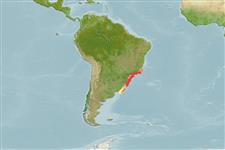Classification / Names
Common names | Synonyms | Catalog of Fishes (gen., sp.) | ITIS | CoL | WoRMS | Cloffa
Actinopterygii (ray-finned fishes) >
Ophidiiformes (Cusk eels) >
Ophidiidae (Cusk-eels) > Ophidiinae
Etymology: Genypterus: Greek, geny, -yos = face, jaw + Greek, pteron, = wing, fin (Ref. 45335). More on author: Regan.
Issue
This species is synonym of Genypterus blacodes (Forster, 1801) according to Nielsen et al. (1999: Ref. 34024). The species page will be removed.
Environment / Climate / Range
Ecology
Marine; demersal; depth range 60 - 200 m (Ref. 9358). Subtropical, preferred ?; 21°S - 40°S, 62°W - 40°W
Southwest Atlantic: Rio de Janeiro, Brazil (Ref. 9358) to northern Argentina (Ref. 27363). Appears to be an unpatterned form of blacodes; status of this species unclear (Ref. 34024).
Size / Weight / Age
Maturity: Lm ? range ? - ? cm
Max length : 68.8 cm SL male/unsexed; (Ref. 27363)
Found on soft mud bottom. Oviparous, with oval pelagic eggs floating in a gelatinous mass (Ref. 205).
Life cycle and mating behavior
Maturity | Reproduction | Spawning | Eggs | Fecundity | Larvae
Figueiredo, J.L. and N.A. Menezes, 1978. Manual de peixes marinhos do sudeste do Brasil. II. Teleostei (1). Museu de Zoologia, Universidade de São Paulo. Brasil. 110 p. (Ref. 9358)
IUCN Red List Status (Ref. 115185)
CITES (Ref. 94142)
Not Evaluated
Threat to humans
Harmless
Human uses
Fisheries: minor commercial
More information
Age/SizeGrowthLength-weightLength-lengthLength-frequenciesMorphometricsMorphologyLarvaeLarval dynamicsRecruitmentAbundance
ReferencesAquacultureAquaculture profileStrainsGeneticsAllele frequenciesHeritabilityDiseasesProcessingMass conversion
Tools
Special reports
Download XML
Internet sources
Estimates of some properties based on models
Phylogenetic diversity index (Ref.
82805): PD
50 = 0.5156 [Uniqueness, from 0.5 = low to 2.0 = high].
Bayesian length-weight: a=0.00209 (0.00128 - 0.00340), b=3.16 (3.02 - 3.30), in cm Total Length, based on LWR estimates for this species & (Sub)family-body (Ref.
93245).
Trophic Level (Ref.
69278): 4.0 ±0.66 se; Based on food items.
Resilience (Ref.
69278): Low, minimum population doubling time 4.5 - 14 years (Preliminary K or Fecundity.).
Vulnerability (Ref.
59153): High vulnerability (57 of 100) .
